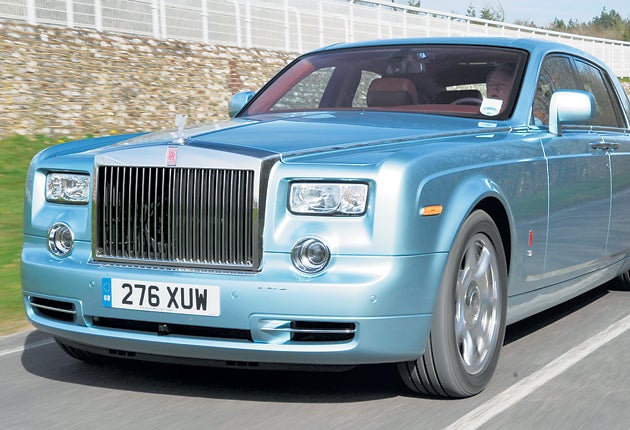Rolls-Royce Phantom 102ex
The only downside to this glorious, powerful and ultra-quiet ride is, as always, the need to recharge

There it was, on the Rolls-Royce stand at the Geneva motor show. An electric Rolls-Royce Phantom, bearing the company's "experimental" designation, 102EX. Under its bonnet was not a V12 engine but a battery pack containing 96 lithium-ion cells, said to be the biggest battery package (at 71kWh) yet fitted to a road car. At the back, where the petrol tank would normally be, were two electric motors producing between them 394bhp and 590lb/ft of torque. That should certainly be enough to haul the mighty Phantom, even if it had put on 200kg in the process.
Very impressive. But why do it? Is Rolls-Royce going green? Not specifically; it is merely bowing to the inevitable. "We can't build 12-cylinder cars forever," says communications director Richard Carter.
So Rolls-Royce, with the help of Lotus, which actually carried out the conversion to Rolls-Royce's engineers' brief, has produced this Phantom Experimental Electric (its other name) instead, so that customers can try it and learn what to expect of a future Rolls-Royce.
Here I am, then, at Rolls-Royce's Goodwood factory in Sussex. That the 102EX is indeed experimental is shown by the big red button to press for an emergency shutdown, the insulated crook-stick in the boot for pulling electrocuted operators away (there are nearly 400 volts flying around), and by the fearsomely complicated start-up procedure involving sequential presses of the start/stop button and counting to 15 while waiting for a couple of distant clicks. This is a new dawn indeed.
I have just alighted from a regular V12-engined Phantom, driven to help calibrate myself for the electric drive. It was extremely quiet and miraculously comfortable, as you would expect, with almost imperceptible gearchanges and aural evidence of engine activity only when the V12's power reserve meter's needle headed to zero and the Phantom whooshed towards the horizon. It still amazes me that something so vast can be as rapid and wieldy as this.
That red button and a battery charge console apart, the 102EX is much like its V12 sibling. The motor and its systems are active, and we're ready to waft. This is uncanny. This Phantom, instead of just being very quiet, makes no sound at all beyond the gentle rush of air past windows and tyres on road. Yet there are huge reserves of energy here. This 102EX powers out of a junction with even more vigour than the V12 Phantom, in a seamless rush of silent acceleration. If I decelerate, 89lb/ft of torque instantly works against the 102EX's motion as regenerative braking, slowing the car a little more than lifting the V12 Phantom's accelerator would achieve. If I press the "Low" button, normally used to lock a Phantom in a lower gear, that braking effect increases to 155lb/ft, enough to make you wonder if the brake lights should have come on.
Once past that impressive getaway, the ultimate acceleration is slightly less vigorous than the petrol-fuelled car's, but 60mph still arrives in under eight seconds. The top speed is limited to 100mph to conserve energy, but on real roads this is one rapid Rolls-Royce. The extra weight has made the ride slightly less serene because it has the effect of stiffening the air suspension, but the pay-off is more precise steering which makes this giant car feel almost agile.
Here the power reserve meter takes on a new role as a power usage and replenishment meter, its needle driven by a laboratory-style stepper motor in tiny, jerky, precise steps. The engineers want to dampen the movements to achieve normal Rolls-Royce calm, but the meter is actually better the way it is because it shows exactly what is happening, instantly and minutely.
There is a snag with this car, of course, and I don't mean the price, which is as yet an unknown quantity. It's that usual electric-car tripwire – the range. Driven gently, with air-conditioning and the heater off, 102EX might cover 125 miles, of which the last 10 or so will be on half power. A full recharge then takes 20 hours on a normal single-phase power supply, or eight hours with a three-phase feed. It's localised luxury travel rather than inter-city commuting, then; that's the inconvenient payback for enjoying energy costs of just 7p a mile, albeit with a total "well-to-wheel" CO2 output equivalent to 193g/km using the Carbon Trust's calculations for UK-sourced electricity.
Charging the Phantom can be wonderfully easy, though. It is fitted with an induction-charging plate underneath, so you drive over a companion plate set in the floor (in your garage or perhaps a future car park) until the charge console in the cabin confirms the car's correct position. Electrons then cross the five-inch gap and charge the battery pack with a surprising 92 per cent energy efficiency. And no, they won't fry an inquisitive cat.
Specification
Model: Rolls-Royce 102EX Phantom Experimental Electric (main picture).
Powertrain: Two 197bhp UQM electric motors and Xtrac gearbox, plus 71kWh, 388-volt, 850-amp battery pack (set under red charging units, above).
Performance: 100mph (limited), 0-60 in under eight seconds, range up to 125 miles, well-to-wheel CO2 193g/km on UK's mainly fossil-fuel electricity.
Join our commenting forum
Join thought-provoking conversations, follow other Independent readers and see their replies
Comments
Bookmark popover
Removed from bookmarks